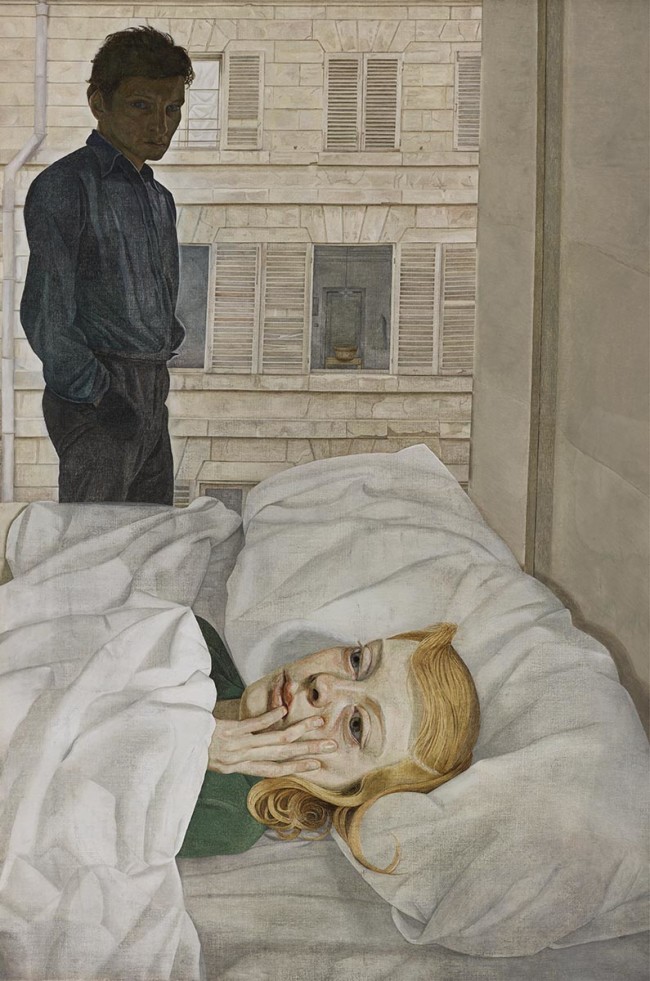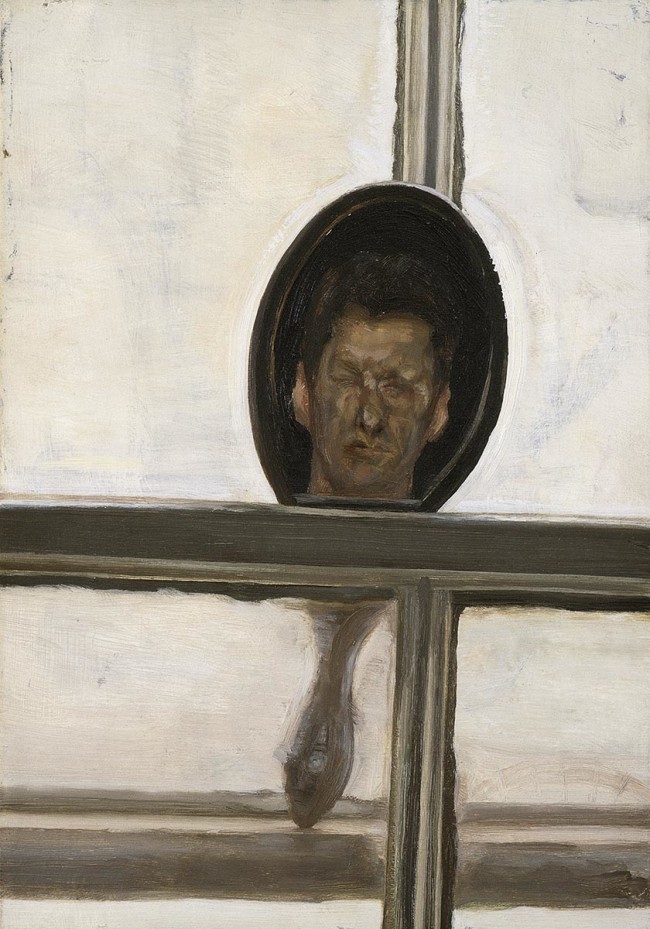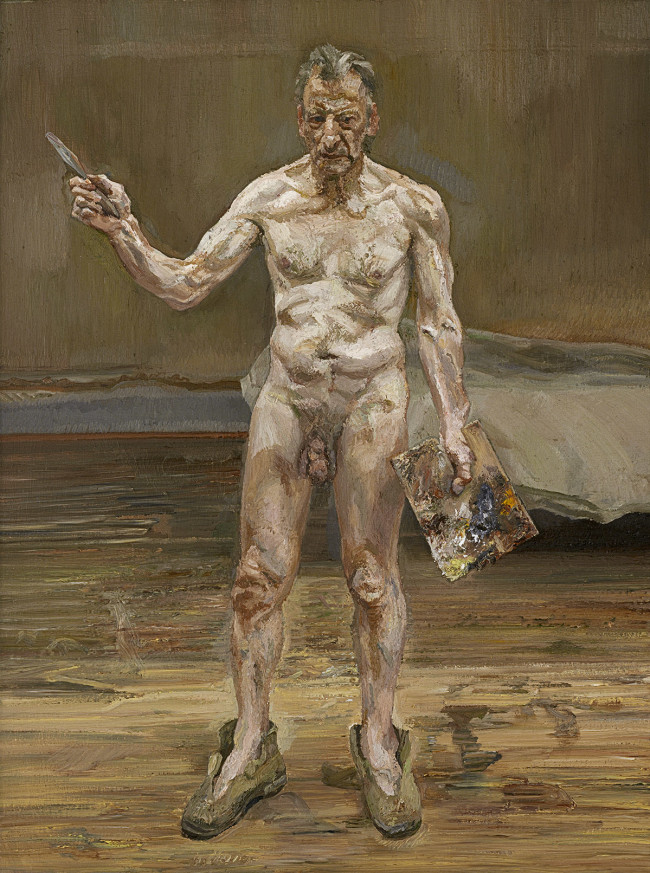Lucian Freud in five self-portraits
Lucian Freud in five self-portraits
By Martin Gayford
Published 3 September 2019
From the focused, linear depictions in his early works, to the triumphant naked portrait painted at the top of his game, Lucian Freud’s self-portraits are a testament to the artist’s indefatigable journey. Friend and art critic Martin Gayford selects five works from our forthcoming exhibition ‘Lucian Freud: The Self-portraits’.
-
From the Autumn 2019 issue of RA Magazine, issued quarterly to Friends of the RA.
-
-
A drawing that reveals a surreal sensibility, as Freud comes of age
Flyda and Arvid, 1947
Lucian Freud made this drawing as one of his illustrations for a book written by Princess Marie Bonaparte of Greece and Denmark. She and her husband, Prince George, were friends of the artist’s family whom Freud got to know when he began to stay in Paris for lengthy periods after the war. She had been a patient and disciple of Lucian’s grandfather Sigmund, and helped him greatly when he wanted to flee Vienna for exile in London. Both Marie and George were, Lucian recalled, “absolutely out of touch with ordinary life”. When she discussed the fee for the illustrations with Freud, she had no sense of the value of money, “as if it were just a commodity like sugar and she just wondered how much I required of it”.
As it turned out, his drawings, intended for the English translation of Bonaparte’s Flyda of the Seas: A Fairy Tale for Grown Ups, were rejected by the publisher. Shortly afterwards – in 1947 or 1948 – he gave this one to his friend Sonia Brownell, who, late in 1949, married George Orwell. A noted beauty, she was known as “the Euston Road Venus” and was the model for Julia, “the girl from the fiction department”, in Orwell’s Nineteen Eighty-Four.
There are visual and personal complications to both the drawing and the gift. This was the time when Freud formulated his first mature style, in sharply focused and closely observed works on paper. It was also the period in which Freud’s work came closest to Surrealism. George Melly, who worked at the London Gallery, where Freud showed in 1947, noted that his early portraits, “displayed, whether he liked it or not, a surreal sensibility”. For his part, Freud soon decided that Surrealism was too stagey; he preferred reality. After all, in the artist’s words, “what is more surreal than a nose between two eyes?”
Nonetheless, there is something not quite naturalistic about the way these two faces are juxtaposed. Is the self-portrait glimpsed through a window or in a mirror? In any case, Freud is not looking at the woman in profile, but out of the picture at the viewer. Ostensibly, she is Kitty Garman, with whom he began a relationship in 1947 and married in 1948. But the female face also resembles Sonia Brownell’s. She and Freud were close in the late ’40s, when he sent her letters and postcards beginning, “Darling Sonia”. Two people are depicted in this drawing, but there is a hint that a third is present.

-
-
-

A painting in Paris that betrays pain in art and life
Hotel Bedroom, 1954
In the early months of 1954, Freud wrote a series of slightly tense letters to Lilian Somerville of the British Council. He was living at the time in a room at the Hôtel La Louisiane in Paris. This establishment is still in business 65 years later. The further side of the rue de Seine, where it is located, can be seen through the window in this painting.
Freud’s correspondence with Somerville was fraught for a number of reasons. One was that he was pushing to complete this new picture for what was to be the most important exhibition of his career to date. Still in his early 30s, he had been selected along with Francis Bacon and Ben Nicholson to exhibit in the British Pavilion at the 27th Venice Biennale.
Freud was concerned about which of his works would be shown in Venice. But most of all he was anxious about the way he was working and his private life. The young woman in the foreground of Hotel Bedroom is his second wife, Lady Caroline Blackwood. They had married the year before, and the relationship was already under stress, partly because Blackwood found herself – as she complained to me many years later – “practically a full-time model”. This was enormously boring to her, and although she was only depicted reading in one picture, remembered doing so during all the sittings “and just looking up when it was necessary for him to do the eyes”. One might imagine she was immersed in Dostoyevsky or Henry James as she posed for this picture. She must also have been cold, as reputedly he broke the bedroom windows to improve the light.
The greatest tension, however, was internal. In the late 1940s and early ’50s, Freud had developed a method of maximum focus and proximity. He sat down, often with the picture itself on his knees, only a foot or two away from the sitter. The extreme concentration and minute observation required were causing him eye-trouble and violent headaches. Afterwards he remembered Hotel Bedroom as the first picture for which he stood up, as he shows himself, moody, hands in pockets, in front of that smashed window. Subsequently, slowly, his paintings became looser and freer. And, he claimed – though in reality the change may not have been so sharp – he never sat down to work again.
-
-
-
A window on the art of reflection
Interior with Hand Mirror (Self-portrait), 1967
This wonderful little picture from the 1960s demonstrates how much Freud’s painting technique had developed in a little over a decade since Hotel Bedroom: from tightly controlled to fluid and richly brushy. It also presents two crucial tools for Freud: a window and a mirror. The first was important because – after his youth – all of his work was done indoors, in a studio.
There were various reasons for this. One was that he found the “changing light outside was a difficulty”. Another was that, always intent on privacy and averse to what he called “attention”, he hated being watched by strangers as he worked, as was liable to occur en plein air. The result was that for him – and for all artists who work from life – “the quality of light in the studio is of great importance”.
Freud was a connoisseur of light. As we talked one day in his Kensington studio, he exclaimed, “The light is very good here just at the moment, better than it was a few minutes ago!” I asked if he meant it was brighter. “Clearer,” he replied. When working on a picture during the day, Freud spent a lot of time standing by his studio window – that was where he took his position, for example, when I posed for an etching, Portrait Head, in 2004-05. “That’s a very good window,” he remarked to me of the high Georgian casement, “practically like working outside”. Another good thing about it, he mused, was “all the time I’ve spent working beside it”.
Doubtless he felt the same about the window in his studio at Gloucester Terrace, a street near Paddington. He must have spent countless hours next to it. This picture is, obviously, a portrait of that window, but also a self-portrait. Since artists cannot, of course, see themselves directly, all self-portraits have to be mediated. Since Freud did not use photography, that meant his self-portraits were all pictures of reflections in mirrors – such an important fact for him that he took to adding the word “reflection” to the title of self-portraits.
As he told Lawrence Gowing, “the information gathered from a mirror is a very different kind of information”. The reason was, he felt, because the light was different. So Interior with Hand Mirror (Self-portrait) is a depiction of these two kinds of light: one coming in from the street, the other reflected contre-jour. It is also a meditation, at once factual and poetic, on the difficulty of seeing oneself.

-
-
-

Perfecting a painterly print
Self-portrait: Reflection, 1996
From the early 1980s onwards, Freud returned with renewed energy to working on paper. His early work had been largely graphic, before he concentrated, from the beginning of the 1950s, on painting. In his last three decades he became a prolific printmaker, finding in etching a medium that perfectly suited his requirements.
The difference was that in his youth he had been essentially a draughtsman-painter – that is, his linear work was dominant – whereas, as a mature master of the brush, he wanted his etchings, he said, “to work like paint”. Self-portrait: Reflection (1996) was his only etching of himself. Like many of his etchings, it was printed by Marc Balakjian, with whom Freud developed a creative collaboration. In this case, that had a decisive effect on the result. Freud was highly sensitive to the optical effect of the clothes an etching sitter wore. For his self-portrait, he had evidently worn a white shirt, and hadn’t registered it with any lines at all, probably because it was so light. The effect was that, when printed, it came out as a blank area – which bothered him. It would have looked like a hole in the image.
As Balakjian pointed out to me, “an etching is the plate”: the drawing consists of the lines bitten by acid in the copper. “But that plate can be printed in many different ways”. Balakjian tried various solutions for the shirt, while Freud watched. Then, when he was cleaning ink off the metal, Freud said, “Just take a print of this half-wiped plate”. When Balakjian did, the artist said, “That’s it! That’s how I want it.” The result is mottled and varied, with a slight roughness, a little like woven cloth. The challenge for the printer was to make 70 identical impressions of that speckled blur.
-
-
-
Naked, at the height of his powers
Painter Working, Reflection, 1993
Though perhaps now best-known as a painter of monumental nudes – or as he preferred to call them, “naked portraits” – Freud seldom depicted undressed people until almost halfway through his career. His first nude dates from the mid-1960s, when he had been working as an artist for nearly three decades; he recalled that in his early years, when he was largely a portraitist, he was a “frustrated painter of the nude”. His phrase “naked portrait” implied that every part of a human being was as unique as the face – thus he tried to “treat the head as if it were another limb”.
As a guest teacher at Norwich School of Art, he set the students the task of painting themselves in the nude. And in several of his own pictures of himself, although only head and shoulders are visible, he seems to be undressed. One of the first was Interior with Plant, Reflection Listening (Self-portrait) (1967-68) in which he is glimpsed through the foliage of a plant. But Painter Working, Reflection, from 1993, is his only full-figure naked self-portrait. It presents the artist, just turned 70, at the height of his powers. This was the period of the works done from Leigh Bowery and Sue Tilley when, after years of relative neglect, he broke through to international renown.
There is something triumphant about the pose, brush upraised like a victorious general’s baton, but the painter assesses himself carefully. His body, though still lithe and muscular, shows the signs of passing time. He confided that as he grew older, he sensed himself weakening, and therefore felt he should redouble his efforts.
Here is the artist, as the title emphasises, at work, wearing nothing but his unlaced studio boots – to protect his feet from falling pigment – and doing what he did from early in the morning until late at night: indefatigably, immensely, slowly toiling on one picture after another. This was the period during which, to an observer, he seemed to be joining the Old Masters. This painting suggests he knew it.

-
-
Martin Gayford is an art critic. His books include Man with a Blue Scarf: On Sitting for a Portrait by Lucian Freud.
Lucian Freud: The Self-portraits will be in the Jillian and Arthur M. Sackler Wing of Galleries, from 27 October 2019 – 26 January 2020. Exhibition organised by the RA in collaboration with the Museum of Fine Arts, Boston.








